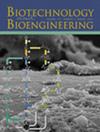使用海藻酸盐膜的3D组织工程中增强细胞培养的可定制堆栈。
IF 3.6
2区 生物学
Q2 BIOTECHNOLOGY & APPLIED MICROBIOLOGY
引用次数: 0
摘要
堆叠细胞培养已经成为组织工程中成功的3D技术,由各种支架材料开发的原型证明了这一点。本研究旨在通过将海藻酸盐膜与聚乳酸材料组成的3d打印堆叠平台相结合来增强细胞培养。该平台采用L929电池优化了三层结构,并与MG-63电池进行了对比。将细胞接种在海藻酸盐膜层上,海藻酸盐膜层由海藻酸盐、琼脂糖、明胶和甘油(1.5:0.25:1:1%w/v)混合而成。藻酸盐含量的增加导致了更大的重量损失,而没有显著影响降解率。相反,琼脂糖含量的减少加速了膜的降解,并使拉伸强度减半(从~6降至~3 MPa)。细胞活力、活/死染色和扫描电镜成像评估各层堆叠培养物的性能。在第7天和第14天,通过Live/Dead染色和SEM成像证实,海藻酸盐膜与L929细胞的生物相容性超过28天。与单层培养相比,堆叠培养对L929和MG-63细胞的每层细胞存活率均保持在70%以上。MG-63细胞,代表成骨细胞分化,表现出增强的结果,与一般培养基相比,骨相关基因(RUNX2, OCN, BMP2, COL1A2)的表达增加了1-2倍,特别是在上层。这些发现强调了堆叠细胞培养支持细胞生长和跨层分化的潜力。该原型为组织工程应用提供了希望,未来的研究旨在利用它进行干细胞培养和大规模3D组织开发。本文章由计算机程序翻译,如有差异,请以英文原文为准。
Customizable Stacks for Enhanced Cell Culture in 3D Tissue Engineering Using Alginate Membranes.
Stacked cell culture has emerged as a successful 3D technique in tissue engineering, demonstrated by prototypes developed with various scaffold materials. This study aimed to enhance cell culture by integrating an alginate membrane with a 3D-printed stacking platform composed of polylactic acid material. The platform featured an optimized three-layer structure using L929 cells and was evaluated against MG-63 cells. Cells were seeded on alginate membrane layers comprising a mixture of alginate, agarose, gelatin, and glycerol (1.5:0.25:1:1%w/v). Increased alginate content resulted in greater weight loss without significantly affecting the degradation rate. In contrast, reducing agarose content accelerated membrane degradation and halved tensile strength (from ~6 to ~3 MPa). Cell viability, Live/Dead staining, and SEM imaging assessed the performance of the stacked culture across layers. The alginate membrane exhibited biocompatibility with L929 cells over 28 days, as verified by Live/Dead staining and SEM imaging on Days 7 and 14. The stacked culture maintained over 70% cell viability per layer for both L929 and MG-63 cells compared to single-layer culture. MG-63 cells, representing osteoblastic differentiation, showed enhanced outcomes, with bone-related genes (RUNX2, OCN, BMP2, COL1A2) exhibiting 1-2-fold increased expression, particularly in the upper layers, compared to general medium. These findings highlight the potential of stacked cell culture to support cell growth and differentiation across layers. This prototype offers promise for tissue engineering applications, with future studies aiming to utilize it for stem cell culture and large-scale 3D tissue development.
求助全文
通过发布文献求助,成功后即可免费获取论文全文。
去求助
来源期刊

Biotechnology and Bioengineering
工程技术-生物工程与应用微生物
CiteScore
7.90
自引率
5.30%
发文量
280
审稿时长
2.1 months
期刊介绍:
Biotechnology & Bioengineering publishes Perspectives, Articles, Reviews, Mini-Reviews, and Communications to the Editor that embrace all aspects of biotechnology. These include:
-Enzyme systems and their applications, including enzyme reactors, purification, and applied aspects of protein engineering
-Animal-cell biotechnology, including media development
-Applied aspects of cellular physiology, metabolism, and energetics
-Biocatalysis and applied enzymology, including enzyme reactors, protein engineering, and nanobiotechnology
-Biothermodynamics
-Biofuels, including biomass and renewable resource engineering
-Biomaterials, including delivery systems and materials for tissue engineering
-Bioprocess engineering, including kinetics and modeling of biological systems, transport phenomena in bioreactors, bioreactor design, monitoring, and control
-Biosensors and instrumentation
-Computational and systems biology, including bioinformatics and genomic/proteomic studies
-Environmental biotechnology, including biofilms, algal systems, and bioremediation
-Metabolic and cellular engineering
-Plant-cell biotechnology
-Spectroscopic and other analytical techniques for biotechnological applications
-Synthetic biology
-Tissue engineering, stem-cell bioengineering, regenerative medicine, gene therapy and delivery systems
The editors will consider papers for publication based on novelty, their immediate or future impact on biotechnological processes, and their contribution to the advancement of biochemical engineering science. Submission of papers dealing with routine aspects of bioprocessing, description of established equipment, and routine applications of established methodologies (e.g., control strategies, modeling, experimental methods) is discouraged. Theoretical papers will be judged based on the novelty of the approach and their potential impact, or on their novel capability to predict and elucidate experimental observations.
 求助内容:
求助内容: 应助结果提醒方式:
应助结果提醒方式:


